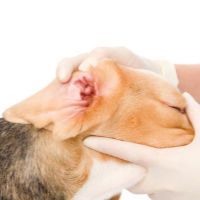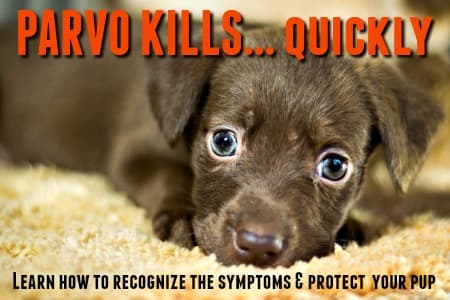FYI: If you buy something through a link on this site I may earn a commission - at NO extra cost to you.
Common Dog Paw Problems
Dog paw problems happen fairly often, and although generally not serious, they can definitely cause Fido discomfort, distress and even pain at times.
How often do you take a close look at your dog's paws?
Unless you're washing, drying or trimming his paws/nails on a regular basis, chances are the answer to this question is 'occasionally', and while this isn't unusual, it's not the best way to keep those hard-working paws healthy and comfortable.
On this page I'll take a look at the most common symptoms of dog paw problems and how to treat/eliminate them. You'll also find remedies for allergies and infections of the paw, preventative care, and tips on keeping paw pads and nails in tip top shape year round.
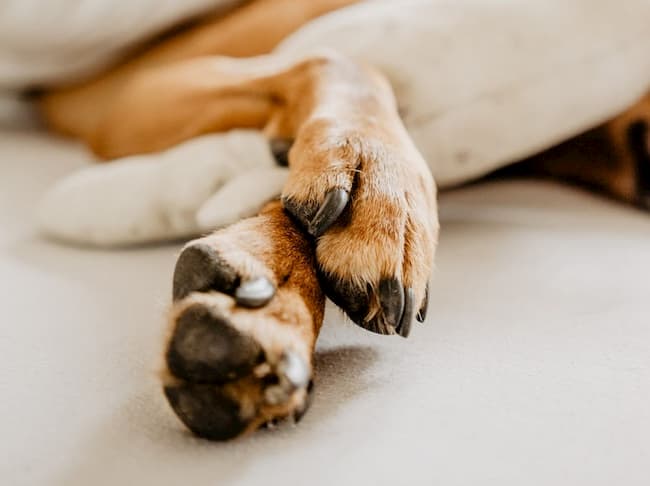
Symptoms of Dog Paw Problems
There are many different things that can cause problems for your dog's feet. This means there are also lots of different signs and symptoms of trouble,. The most common signs of dog paw problems include:
- Constant or repeated licking/biting at paws
- Swelling or redness of paw/toes
- Cracked pads
- Visible growth, wart or cyst
- Cut or tear on pad
- Blistered or discolored pads
- Torn or damaged nail/s
- Limping or lameness
The best way to make sure your dog's paws are in good shape is to examine them regularly. Look carefully at all the pads, and between each toe and be on the lookout for any of the symptoms listed above.
Causes of Dog Paw Problems
A dog’s paws are sturdy, and well designed for their purpose, but there are a fair number of problems that can show up from time to time. Knowing how to recognizes signs of trouble, and what to do about them, is important to prevent more serious problems down the road.
The most common paw problems are caused by one of the following:
Several of the above can cause inflammation, also known as Pododermatitis, and this inflammation can be extremely irritating and even painful for your dog.

About Dog Paw Allergies
One of the most common dog paw problems is often not recognized by pet owners as a problem at all, partly because it's so common and mistakenly considered to be 'just a habit'.
What behavior am I talking about?
Licking! Specifically paw licking.
Dog allergies are pretty common, and the causes are varied. Allergies often show up as skin problems, and the paws are one of the most common locations for symptoms.
Food allergies is one of the most likely culprits for lots of dogs, but grass and other topical allergies plus seasonal allergies also affect a large number of dogs.
Here are some signs that your dog's paw problems could be caused by allergies:
- Red, itchy paws (often between the toes)
- Swollen paws
- Discoloration (browning) of the fur/nails from saliva
- Constant or repetitive licking/biting at paws
If you notice that your dog generally spends more time licking his paws in the Spring, or Fall, it could be that seasonal allergies to blame. If the licking is chronic, and year-round, then food allergies are the most likely culprit.
If you don't catch it early enough your dog could lick his paws raw which puts him at risk of developing a bacterial or yeast infection.
The foods most likely to cause allergies in dogs include protein sources such as eggs, pork and beef. Dairy is another common trigger as are grains such as wheat, corn and soy. Artificial additives and preservatives, sweeteners or colors can also cause allergies.
Check out this page to take an in-depth look at dog food allergies plus find loads of information on symptoms, treatment, prevention and dietary changes that can help.
help for dog paw allergies
If your dog has itchy, irritated paws and you suspect allergies are to blame, there are a few things you can do make him more comfortable:
- Look at his diet and remove food allergens or triggers
- Keep his paws clean and dry
- Use boots or shoes if grass or outdoor chemicals are triggers
- Use topical products to relieve itching
In addition to these things, it's important to discourage your dog from licking or biting at his feet as this sets up a never-ending cycle of lick-itch-lick-itch which makes the situation worse.
You can even use an Elizabethan collar (also known as the Cone of Shame) if your dog is licking his paws constantly or causing the skin to swell, break or bleed. Once you get them dry, and are able to keep topical cream/balm/salve on them for a reasonable period of time, his paws should heal and he'll be less inclined to lick them.
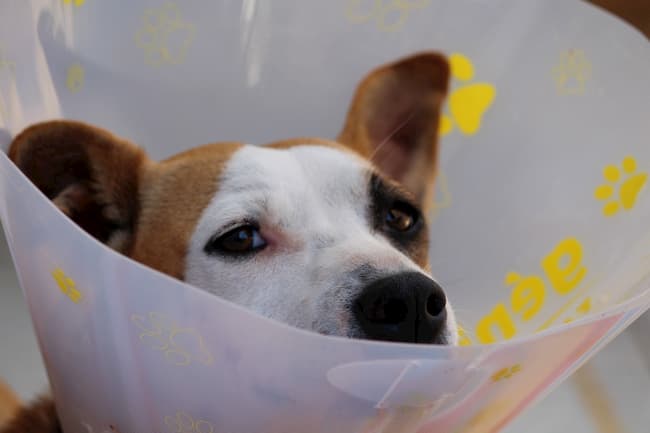
Your veterinarian may prescribe a hydrocortisone cream or spray to reduce inflammation and itching. This is usually effective, but it's not a great product to put an area where there is at risk of it being licked off. Although generally considered safe for use on dogs (and cats, horses and other animals) it can cause drooling or foaming at the mouth and isn't meant to be ingested.
If you use a hydrocortisone product of any kind I'd suggest using the cone, or some other way of preventing your dog from licking it off.
There are some great natural products that help relieve symptoms of dog paw allergies. Some are topical, others come in the form of supplements which can help reduce allergies and improve skin and immune system. Obviously the topical treatments will provide faster results, supplements are a long-term solution and using both is going to get better results.
If the combination of allergies and constant licking at his paws results in an infection there are other products, both veterinary prescribed or natural that can help. Check out the section below for more on these.
home remedies for itchy dog paws
If you prefer home remedies using natural ingredients here are a couple of suggestions for relieving Fido's itchy paws.
Baking Soda Paw Soak
Baking soda is well known for it's soothing and anti-inflammatory properties (I remember taking baking soda baths to relieve the itch when I had chickenpox as a child). You can use this pantry staple to help reduce itching and inflammation on your dog's paws. Put a couple of handfuls of baking soda into a gallon of cool water, mix thoroughly then soak your dog's paws in the solution. Or put a tablespoon, or two, of baking soda into two cups of water and pour into spray bottle. Spritz your dogs feet well and allow to dry.
Apple Cider Vinegar Paw Soak
Apple cider vinegar is a great tool to have in your home remedy chest. It's antibacterial and anti-fungal properties make it highly versatile and it can be taken internally as well as used topically.
To help sooth itchy dog paws you simply need to mix up a half-and-half (50:50) solution of ACV and water. This makes a perfect paw soak and you can happily let Fido soak his paws in it for several minutes.
This option is easiest with small dogs as you need less of the solution and can soak all four paws at once. For larger dogs you may just want to hold his paws in the solution one at a time. Alternatively you can put the ACV/water solution into a spray bottle and liberally spritz his paws.
Chamomile Tea Paw Soak
Chamomile is soothing and relaxing, and chamomile tea makes an excellent soak or spritz for itchy dog paws.
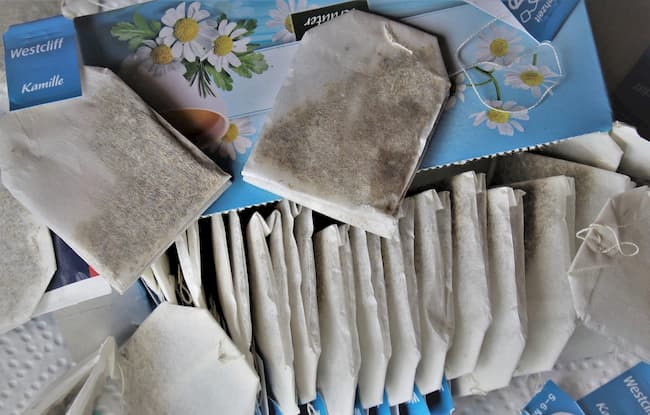
Simply steep several chamomile tea bags in warm water for up to ten minutes and then soak your dog's paws in the tea, or put it into a spray bottle and spritz his feet. Green tea bags can be used instead of, or as well as, chamomile tea bags.
Colloidal Oatmeal Paw Soak
Colloidal oatmeal is another proven natural remedy for itching and inflammation. Making a colloidal oatmeal soak for your dog's itchy paws is super easy. Simply stir colloidal oatmeal into warm water and mix until milky. Use a handful or two of per gallon of water for soaking, or add one or two tablespoons to two cups of water and spritz/spray on Fido's paws. You can buy ready prepared colloidal oatmeal or make your own by grinding plain rolled oats into a fine powder using a food processor or coffee grinder. If you choose to make your own be sure not to use flavored or processed oats as they contain other ingredients. Use plain unflavored oats only.
Natural Dog Paw Salves
Both coconut oil and pure aloe vera or aloe vera gel (WITHOUT alcohol) can be very soothing for a dog with itchy paws.
If you have an aloe vera plant, break off a stem and squeeze out the juice. This is the purest and most direct form of aloe vera, or buy a pure aloe vera gel, both options will be cooling and soothing to hot, irritated and itchy paws. Coconut oil can be a little messier, but is moisturizing and soothing. Choose organic virgin (unrefined) coconut oil. It should be liquid at temperatures above 78F, and solid at lower temperatures. Rub the oil into your dogs pads and between his toes to help relieve the itch.
discourage licking after soaking!
Whichever soak you use, I'd recommend discouraging your dog from licking his paws after the treatment.... all these home remedy solutions are totally safe if ingested, but licking will disrupt/cancel out their beneficial effects.
Dog Paw Infections
Dog paw infections (aka Pododermatitis) can cause intense itching, which results in your dog constantly licking his paws, sometimes until they're raw which obviously makes the itching even worse!
There are different types of infection that can affect dogs paws. The most common are bacterial, yeast or parasitic infections (often mites).
Infections can cause a LOT of discomfort/pain and in the case of bacterial infections the problem can become serious if not treated properly.
If you think your dog's paw may be infected it's important to have him examined by your veterinarian so that you can get a professional diagnosis and the right treatment put in place.
Dog paw fungal infections
The most common fungal infections to affect your dog's paws, are yeast infections and ringworm.
Yeast infections are caused by an overgrowth of the natural yeast organisms which normally inhabit your dog's body and have legitimate functions.
If the immune system is impaired or overloaded (due to illness or allergies for example), sometimes yeast will multiply in the body at an above-average rated and cause a variety of symptoms. Allergies are the most common cause of dog paw yeast infections.
Although any breed, or mixed breed, can be troubled by yeast infections, some breeds are more prone to developing them than others. These include:
- Basset Hound
- Bulldog
- Cocker Spaniel
- English Setter
- German Shepherd
- Maltese
- Shih Tzu
- West Highland Terrier
Yeast infections aren't limited to your dog's paws either. Yeast can cause ear problems, digestive issues, skin problems, hair loss and more. Yeast infections in dogs can also be caused by antibiotic use (which imbalances the gut and allows yeast to thrive and multiply, causing havoc in a variety of ways.
The most common symptoms of a dog paw yeast infection include:
- Redness and/or swelling of paws
- Redness or inflammation between the toes
- Red or swollen nail beds
- Darkening or discoloration of nails
- Red or brown coloring of hair on paw and between toes
- Intense itching
- 'Yeasty' smell (this is the corn-chip smell you hear about)
If your dog gets a yeast infection in his paws it's generally pretty clear that something is wrong, and causing him discomfort. Some dogs get recurring, or chronic, yeast infections and if this happens it's often caused by a dietary allergen.
Luckily yeast infections are very easy for your veterinarian to diagnose, and there are a variety of anti-fungal medications and products that are effective at eliminating them.
Corticosteroids such as hydrocortisone can reduce inflammation and irritation.
Chlorhexidine is a disinfectant and antibacterial that's found in a variety of products used to treat dog skin infections and conditions. You can usually find products with these active ingredients at your veterinary clinic as well as online.
Anti-fungal products are available as creams, shampoos, baths, wipes and more. They can also be given orally.
Dogs can develop a secondary bacterial paw infection as a result of excessive licking at paws which are irritated and itchy due to allergies or yeast.
This happens when, over time, the saliva and constant abrasion of the tongue cause the skin to break down/split and bacteria then enters the skin through these openings.
dog paw yeast infection home remedies
There are a number of ways that you can treat your dog's yeast infection at home using natural products. But, if these don't give him relief and you don't see major improvements then I'd recommend having your veterinarian examine him and suggest/prescribe medications that could help. Yeast can be very persistent, and needs to be treated and eliminated quickly.
One of the home remedies you could try for your dogs yeasty paws is the Apple Cider Vinegar Paw Soak mentioned above. When applied topically the ACV can kill off the yeast and taken internally it can help strengthen Fido's immune system and re-balance his gut flora. Guidelines for dogs are to give 1 tsp to 1 tbsp of ACV per 50lbs of body weight. I'd recommend pouring it over your dog's food rather than adding it to his water, especially in summertime in case he dislikes the taste. You don't want him getting dehydrated.
You can also use coconut oil and/or oregano oil to tackle the yeast from two angles. Both have antifungal properties.
Choose virgin, unrefined coconut oil and rub it into your dogs paws and between his toes. You can also add
With oregano oil you need to first choose only high quality wild harvested oil, dilute it with virgin olive oil or coconut oil (this will need to be above 78F so that it's in liquid form)... ONE DROP of oregano oil to one teaspoon of coconut or olive oil. Never give your dog undiluted oregano oil. Add this mix to his food daily, or several times a week.
**Never give oregano oil to dogs who have had seizures or have neurological issues.

Because an overgrowth of yeast is caused by an internal (gut flora) imbalance, taking certain supplements and probiotics is an effective way to eliminate the root cause of the itchy, uncomfortable symptoms like itchy paws (ears and skin are also often affected).
These allergy relief/immune support dog treats are designed to support the immune system and reduce inflammation. They contain pre and probiotics, antioxidants apple cider vinegar, salmon oil, dog colostrum (super for immune support) and quercetin. Or look at this Pre + Probiotic Powder with digestive enzymes to improve digestion, strengthen your dog's immune system and restore a healthy balance of flora in his gut.
Another product that it definitely worth checking out is the N'zymes Skin Kit range. Each kit contains a selection of oral products specifically formulated to keep your dog's skin healthy by balancing the intestinal flora.
Bacterial dog paw infections
While the symptoms of a bacterial dog paw infection are likely to be very similar to those of dog paw allergies or yeast infections, the cause is often different.
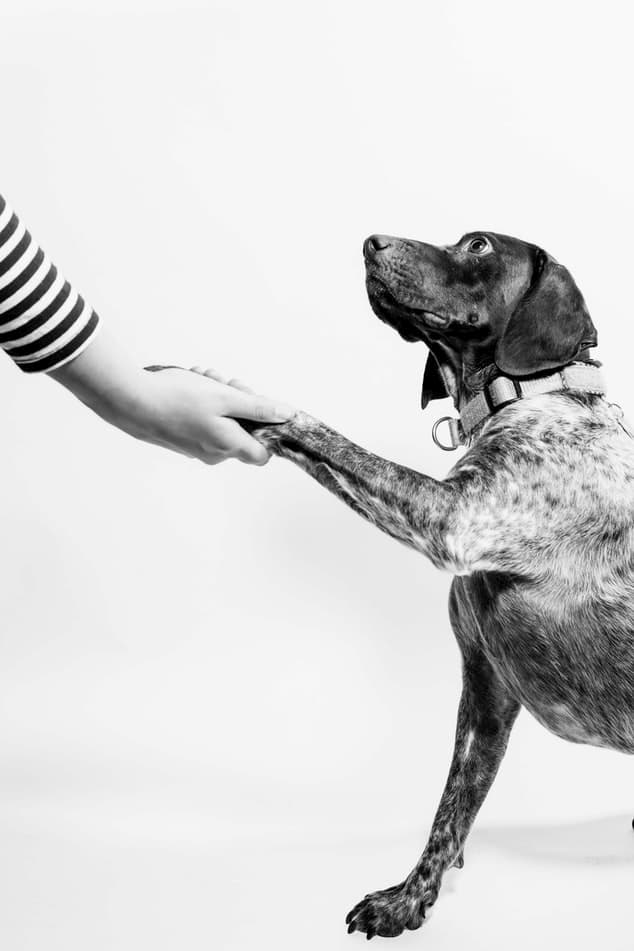
Bacterial infections can happen due to an injury (a cut paw or torn nail for example) or by getting a foreign body stuck between the dog's toes or in the paw pads (glass, nail, wood or foxtail for example).
Secondary bacterial paw infections can happen as a result of excessive licking at paws which are irritated and itchy due to allergies or yeast. This happens when, over time, the saliva and constant abrasion of the tongue cause the skin to break down/split and bacteria then enters the skin through these openings.
Whatever the underlying cause of the bacterial infection in your dog's paw, you're likely to see redness, swelling, tenderness or pus in that area. Fido's paw will be painful and if there are underlying allergies or a yeast infection it will also be very itchy. Your dog will likely lick at it often in an attempt to relieve the discomfort. Lameness or limping is also often seen with bacterial infections of the paw.
Because bacterial infections can change from being localized to systemic (ie spread through the body in the bloodstream) it's important to get them diagnosed and treated quickly. Of course there's also the the fact that if your dog has a bacterial infection in his paw it will be painful and he will be feeling miserable! Helping him feel better quickly is important.
Your veterinarian is the best person to diagnose an infection and also to recommend/prescribe treatment. In some cases oral antibiotics might be needed.
treating bacterial dog paw infections
Treating bacterial infections (of any sort) is best left to the professionals and if your dog is showing signs of having an infection in his paw (or paws) it's important to have him seen by your veterinarian as quickly as possible. Infections can turn nasty quite quickly so better safe than sorry.
If you have to wait a few hours, or even a day, for an appointment there are some simple at-home treatments you can do to help relieve the discomfort and hopefully prevent the infection from getting worse... IF the infection is recent, and currently mild.
Infections that have been there for a while, or which look severe, are causing your dog pain or if he's acting unwell, need to be seen by a veterinarian on an emergency basis!
The first thing to do is to make sure there's nothing stuck in your dog's paw or between his toes. Check gently and carefully and if you find anything remove it carefully with tweezers (if it's in deep or you can't remove it yourself without causing Fido pain or distress, then take him to your veterinary clinic to have it done for you).
Next step is to make sure the area is clean. The best way to do this is to soak your dogs paw in a warm solution of salt water. Simply dissolve one or two teaspoons of salt (sea salt is best if you have it) in a gallon of warm water. Then soak your dog's paw for several minutes. Salt water is naturally cleansing and healing, it's also soothing.
Then dry the paw very gently and if you have an antibacterial or antiseptic spray/salve/ointment on hand you can apply that to the infected area. To stop Fido from licking this right off, either use a cone or bandage the paw (not too tightly!) to allow the product to penetrate the skin and give it a chance to work.
One of my favorite naturally antibacterial products for my pets is Silver Honey (available as an ointment or spray gel). Colloidal/nana/micro silver is a power antibacterial substance and I use it for myself as well as for my pets.
Another effective option is this Remedy + Recovery medication whose active ingredient is antimicrobial Benzalkonium Chloride.
Of course if all you have on hand is your family's antibacterial cream that is also a perfectly acceptable choice!
Miscellaneous Dog Paw Problems
Although allergies and infections are the most common causes of dog paw problems, there are a host of other issues that can crop up from time to time, these include:
- Injuries such as cuts or tears on the pad
- Paw pad damage from excessive heat or cold
- Foreign bodies
- Bee stings on paws
- Parasites
- Growths such as cysts or warts
- Nail Issues
- Paw Pad Problems
Dog Paw injuries
Your dog's paws work hard every day and as there isn't any protection between them and the ground sometimes they get cut, grazed or torn.
Extreme weather, rough terrain (such as sharp rocks) or yard chemicals or rock salt can all cause damage. Here's what to do if this happens:
- Remove any splinters, pieces of glass/dirt/debris using tweezers
- Clean area with salt water solution (see above) or plain warm water
- Apply antibacterial product if you have any (also see above)
- Bandage or cover paw to protect from dirt/licking
- Keep injury/bandage as clean and dry as possible for healing
Superficial or minor paw pad injuries generally heal fairly quickly and easily, and within a week or so Fido's paw should be looking significantly better.
Deep cuts or injuries, or those that won't stop bleeding need to be evaluated by your veterinarian. The same goes for any foreign object (glass/wood or metal splinter/foxtail etc.) that is deeply embedded.
These types of injuries may take two to three weeks to heal completely.
paw damage from heat or cold
Dogs paw pads are tough, but they can still be injured by ground that it too hot or too cold. Ice-melt products and salted roads in winter time can also do damage.
In hot weather always walk your dog early in the morning or later in the evening when the asphalt/concrete is cooler. Grass is always a lot cooler than man-made surfaces and is the best choice in hot weather.

Try the 10 second 'hot pavement' test.... place your hand palm down on the ground. If you can't hold it there for ten full seconds without feeling discomfort then it's too hot for your dog's paws!
Signs that your dog has burned his paws include limping or lameness, whining or unusual vocalizing, change in paw pad color (lighter pads may become darker, or dark/black pads may look red). Over a day or two blisters will usually appear on the paw pads, these are likely to burst and result in open raw areas of skin. Dogs often lick these to help keep them clean and relieve discomfort, however constant licking can cause it's own problems (as discussed under the dog paw allergies/infections sections of this page). So use a bandage, cone or some other deterrent to stop this from becoming an issue.
Pawflex Medimitts are medical bandage booties that are a convenient way to cover injuries/burns or to prevent licking. You can also find waterproof covers designed to fit over them and be used outside. However, some dogs will chew off bandages/bootees so it's important to watch for this.
Very minor burns may heal without treatment, although keeping the pads clean and using an antibacterial spray is important. Paw Soother is an all natural, organic paw balm which soothes and moisturizes. It can also be helpful for dog paw burns or injuries.
However, moderate to severe dog paw burns always need veterinary attention. They may need to be professionally cleaned and bandaged and antibiotics might be prescribed because burns can easily become infected.
When it's very cold, icy or snowing outdoors your dog's feet can get uncomfortably cold, dry or chapped, suffer chemical burns from de-icing products (which are also dangerous if ingested, ie. your dog licks his paws), or even torn/but by salt on the roads.
The best protection is to put boots or shoes on your dog during the worst of the weather. If this isn't possible then using a good paw protection product, like Musher's Secret Paw Wax, or Paw Pad Shield Wax, is the second best option.
It's also important to check your dog's paws and between his toes during your walk. Icy/snow can build up between the pads and toes and cause irritation and pain. After your walk, be sure to check pads for this as well as rinse them with lukewarm water to remove any debris or chemicals and dry them thoroughly.
foreign bodies in dog paws
Your dog is walking on all kinds of surfaces, and usually not looking where he's going, so it's inevitable that he'll step on things that can hurt him from time to time.
Sharp objects such as nails or glass can cause punctures or cuts to your dogs' paws, and any injury that happens needs to be cleaned and treated quickly to prevent secondary infection.
foxtails
One nasty (and sneaky) thing which can cause all kinds of problems is the Foxtail.
Foxtails (aka Spear Grass) are a little cluster of sharp, seed heads from this weed, which looks like grass.

These little seeds might not look like much but they're nasty, dangerous 'arrows' which pierce your dog's skin and then travel THROUGH it and into the tissue underneath.
They don't just stop there either. They keep moving inwards and have even ended up inside internal organs including the brain. This is obviously extremely dangerous and can be fatal to a dog.
Paws aren't the only place foxtails can enter your dog's body and cause havoc. They can be inhaled or ingested, or enter through the ears or eyes, genital area, or pretty much anywhere on his skin.
At first you may notice your dog licking or biting at his paw and if you're lucky you'll find the foxtail buried somewhere between his toes or pads. At this point you may be able to remove them with your fingers or tweezers. Brushing your dog after walking in long grass can help remove them from his coat and is a good habit to have.
If you don't see the foxtail at this point you MAY notice a swelling or inflamed area on his paws/toes (or anywhere on his body) during the next few hours, or day or two. Areas like this should always be examined by a veterinarian right away. With luck (again) the foxtail will be removed by your vet before it goes too far or does too much damage, and if antibiotics are needed they can be given.
If you even THINK your dog may have inhaled or ingested a foxtail, get him to your veterinarian immediately.
bee stings on dog paws
If your dog happens to step on a bee he's likely to let you know about it by limping, whining or vocalizing, or licking at his paw.

Bees usually leave their stinger behind so the first thing to do is to examine your dog's paw and remove the stinger carefully. Don't use tweezers to remove a bee's stinger because you'll squeeze more of the bee venom into the skin. Instead scrape a credit card or your fingernail across the surface of the paw pad/skin until it catches under the stinger, then try to flick it out.
Once the stinger is out use a cold compress or ice to help relieve the itch and prevent swelling. You can use the baking soda paw soak from the home remedies for itchy paws earlier in this article. Or even make a paste from baking soda and water and apply it to the paw/skin.
Some dogs may have an allergic reaction to a bee sting. Symptoms of this include hives and extreme swelling of the area where stung as well as other parts of the body such as face, eyes, tongue or muzzle. Severe allergic reactions might cause difficulty breathing and are a veterinary emergency. If you notice any swelling (other than some minor to moderate swelling at the site of the sting) or your dog appears unwell or seems disoriented, anxious or in distress it's important to get him to a veterinary clinic immediately.
Benadryl (recommeded dosage for dogs is 1/2 mg per pound of body weight) may help relieve minor symptoms but ALWAYS consult a veterinarian before giving medications to your dog and in the potential case of an allergy do not try to treat it yourself. Professional help is needed.
parasites
There are a few parasites which can cause dog paw problems, the most common being ticks. Demodex mites, and even fleas can also set up shop in the tender skin between your dog's toes and cause itching, inflammation, swelling and pain.
Ticks are also nasty little creatures who love to burrow into the soft skin between your dogs toes (although they will happily attach themselves to any part of Fido's body, toes, ears, groin and even gums are popular places to find them).
Once attached they will suck your dog's blood, and may simultaneously transmit tick borne infections such as Lyme Disease, Ehrlichiosis, Rocky Mountain Spotted Fever and more.
The best way to remove a tick is with a tick remover like this Tick Stick or the Tick Twister because you want to get the whole creature removed, including the head. Pulling with tweezers is more likely to leave the head behind which can cause infection.
Obviously using a good flea and tick medication is recommended because both these parasites can make your dog really sick. There are also natural flea control options if you prefer the non-chemical route.
Demodex Mites aren't visible to the naked eye, and generally if there are mites causing problems on your dog's paws they are also causing problems elsewhere on his body! Check out this page to learn more about mite infestations and mange.
Harvest Mites (aka Chiggers) which can attach themselves to your dog's paws and cause severe itching and discomfort. If you've ever had Chiggers on your ankles/feet you won't forget it quickly! These tiny red/orange mites CAN be seen with the naked eye but they're not necessarily easy to remove.
A home remedy for Harvest Mites is as a warm Epsom salt and Dawn washing up liquid bath or footsoak can relieve the itching somewhat and encourage the mites to un-attach themselves.
If your dog is very uncomfortable or you see any signs of increasing inflammation, swelling or redness which could indicate infection or pododermatitis it's important to have your vet examine your poor pup's feet as he can prescribe topical treatment to help.
Fleas are usually found all over your dog if there is an infestation. The places they are most easily seen in numbers are often around the ears, neck and groin/armpit areas. They can also dig in between your dog's toes. Check out these pages for help dealing with these annoying little parasites Fleas & Ticks, Home Remedies for Dog Fleas, Natural Flea Control, Flea Medications.
dog paw cysts & growths
Cysts, lumps or growths can occur on your dog's paws just as they can on any other area of his body.
The most likely location on the paw is between your dog's toes, but they can show up elsewhere. As it can be difficult to determine the cause of the problem, or whether you're looking at a cyst, a growth, a foreign object (the body can enclose foreign objects with fluid/swelling) or infection, it's always advisable to have your veterinarian take a look at any growth, swelling or cyst.
He/she can make an accurate diagnosis and set up a treatment plan to take care of it.
dog nail issues
A dog's nails can split or break, can get too long, be cut too short, or become inflamed or infected.
The most common injury to a dog's nails is a tear, which happens when the nail gets caught on something, Dew claws are a prime target for this also.
Too long toenails can split or break more easily, and if they grow excessively long they can become ingrown toenails which damage the skin of the foot or paw pad and cause pain or infection.
Excessive paw licking due to allergies can discolor your dog's nails or cause inflammation at the nail bed which may become infected.
dog paw pad problems
Your dog's paw pads are thick, tough and strong, but they're not invincible.
Dog paw pads can be burned or blistered by walking on ground that is too hot, or too cold, damaged by sharp objects/foreign bodies, and by chemicals such as de-icer, salt and yard treatments.
Superficial or minor injuries can sometimes be taken care of with careful cleaning and covering with a clean bandage or booties, but deep cuts, lacerations, burns etc. need to be seen by a veterinarian right away for the proper treatment.
Paw pads can also become dry and/or cracked and there are multiple possible causes for this, including chemicals (floor cleaners, yard treatments, salt), excessive licking due to dog paw allergies, nutritional deficiencies, health conditions including hormonal problems, auto immune conditions and more.
As long as there's no underlying disease, paw pad dryness or cracking can usually heal with a little TLC. Keep paws clean and dry them well after bathing, or walks, use an antibiotic ointment for minor cuts or cracks to prevent infection, and cover them with booties if necessary (the Pawflex Medimitt is a good option here. You can also get waterproof covers for the Medimitts so they can be used outdoors).
Paw balms can be soothing and moisturizing and there are options for both healing and prevention of dry, cracked dog paws.
Here are a couple that you may want to check out:
Soothing & Healing
- Natural Dog Company Paw Soother Balm (organic), also available in stick form 0.15 oz trial size and 2.0 oz size, perfect to keep in your car/purse
- Vet's Preferred Paw Balm Healing Therapy
Prevention & Protection
- Natural Dog Company Pawtection Balm
- Musher's Secret Dog Paw Wax (protects against snow, ice, salt, sand etc.)
How to Keep Dog Paws Healthy
Your dog's paws may be one of the most neglected parts of his body. We groom/bathe our dogs, wipe their eyes, clean their ears, cut their nails and so on, but how often do we actually examine their paws?
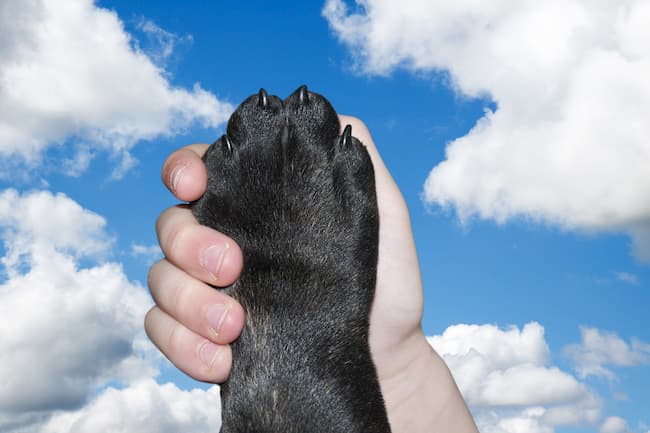
It's always better to prevent a problem than to have to deal with it, so examining Fido's paws regularly and looking for cuts, growths, stickers, ticks (a favorite place for ticks to hide is between your dog's toes!) etc. is important. As is protecting those paws in extreme temperatures.
Taking care of a problem before it causes symptoms is much quicker, less expensive, and less stressful for your dog.
Here are some easy steps to keeping your dog's paws healthy:
- Examine paws regularly (daily is ideal, it only take a minute to do)
- Keep paws clean and dry
- Trim nails regularly
- Trim hair between paws (longhaired breeds) regularly
- Avoid walking on hot surfaces. Use boots if needed
- Avoid walking on snow/ice/salted-areas. Use boots if needed
- After walks check paw pads/toes for foxtails, stickers and ticks
- Be aware of how food allergies can affect your dog's paws
As you can see, preventing dog paw problems is fairly straightforward as long as you're on the lookout for them and take action quickly.
Here's to healthy paws!!
you might also like...
- Home
- Dog Health Information
- Dog Paw Problems
FTC Disclosure: Some pages on this site contain affiliate links. I may earn on qualified purchases.










